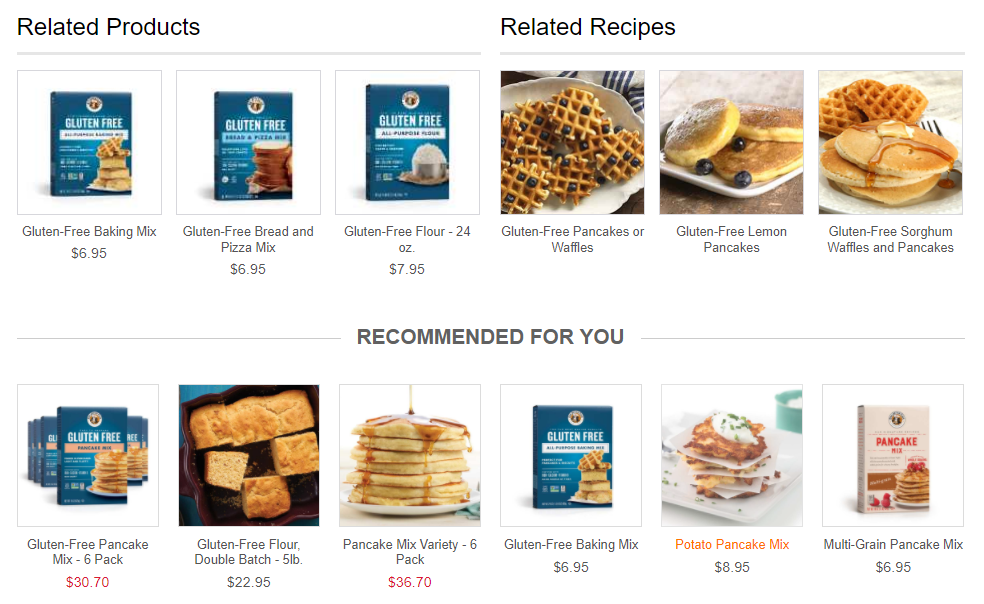
The pressure is on for retail businesses to deliver on big sales growth expectations. That’s in the face of slow consumer spending growth combined with the tectonic shift in traditional retail channels.
You need to turn more shoppers into buyers. You can’t afford for your investment to bring more shoppers in the door or onto your e-commerce store that leave with an empty cart.
That’s why optimizing your customer experience is more important than ever.
This retail executive brief helps you better understand:
- How customer experience strategies are evolving
- What customer experience metrics to track and analyze
- How to improve your customer experience using top trends in 2018
Let’s first dig into how customer experience is changing.
What is Customer Experience Today?
In the past, customer experience strategies focused on the discrete interactions shoppers had in the sales process. These touchpoints took on even greater importance with online retail channels simply because it was easier to track and optimize each webpage leading up to a sale.
However, this touchpoint-focused approach to improving customer experience can easily miss one critical element… the customer journey.
The journey is the customer experience.
The overall journey can still disappoint customers, even if your online store design, in-store layout and staffing are executed well on individual touchpoints.
Understand the customer journey in your shoppers’ terms. Customer journeys include many things that happen before, during, and after the actual purchase experience.
The journeys can be quite long, though the purchase decision can be extremely fast. Consider the multiple channels, devices, and, yes, direct interactions that may occur over days or even weeks.
Put yourself in their shoes. You buy products for yourself all the time. Think about your entire experience and why you made a purchase or didn’t.
Ask questions like:
- Where and when did you first learn about a store?
- What was your first impression of the brand?
- What triggered you going in the store or to the website?
- How easy was it to find what you wanted?
- How did you feel about the product price and value? Product quality? Selection for you?
- How did you feel about the shopping environment in-store or online?
- What sales help, customer service or employee interactions did you have?
- How did the purchase transaction go? Was it fast and easy?
- How did you get your product? Was shipping fast? Did you need to exchange or return?
Always be asking how you can improve that journey.
Next you need to figure out if you’re on the right path to improvement.
Customer Experience Measurements for Success
How do you know you are improving your customer experience? You’ll want to look at the numbers.
It’s very tempting to dive right into the weeds. Retailers now have so many powerful analytics tools. And data collection is getting easier.
However, direct contribution to macro financial metrics and sales trends can be difficult. Remember, your customer experience is a holistic journey. So your best customer experience metrics are more macro. They are not necessarily analyzing and optimizing discrete touchpoints.
Start by measuring key customer experience outcomes, customer feedback, and employee feedback.
Financial Metrics
The most common outcome metrics are financial. Let’s assume you are already tracking total revenue, profit, and transaction volume. Great financial indicators of your customer experience is Revenue per Customer and Average Transaction Value.
Make sure to also track Revenue per Visit (RPV) for your online channel or if you are a pure e-commerce business. This metric estimates the incremental value of each visitor to your online store. Simply divide your total online revenue by the total number of unique visitors to your website.
Customer Satisfaction
You also need to measure your Net Promoter Score (NPS) to capture how customers feel about you. NPS is a fantastic customer satisfaction metric to track over time. Customer experience and customer satisfaction are closely correlated.
But the most actionable customer experience metric in your NPS comes from the answer to the follow-up question – “Why did you give that rating?”
Categorizing the results of this open-ended “Why” question helps you measure the impact on different factors in the customer journey in your customers’ terms. For example, you may group results by broad areas like customer service, products, or pricing. Or you can go more granular into the touchpoints like checkout experience, shipping, or return policies.
Learn more by further breaking down your NPS by customer segments. You can segment by geography, gender or age demographics, order revenue, or purchase frequency or recency.
Employee Satisfaction
Lastly, you should also measure your Employee NPS. Employee satisfaction is also highly correlated with customer experience. Happier employees lead to better customer experiences.
After all, your employees are most responsible for delivering a great customer experience. All your employees contribute. Even someone behind the scenes in HR, the warehouse, or web development have an impact that trickles into the experience.
Here again, look closely at the “why” to measure and track the drivers that influence your employees’ feelings. Those feelings result in behaviors and actions that directly and indirectly impact your customer experience. Listen to what they say and recommend.
Track these financial and satisfaction metrics consistently. That’s how you will know your customer experience is on the right path.They are your “North Star” numbers.
Once you’ve established those customer experience measurements, you can then go deeper into specific success metrics for operational improvement initiatives. Use Google Analytics and e-commerce platform results for your online channel.
Now let’s look at the latest trends you can leverage to boost your customer experience metrics and sales.
3 Technology Trends that Help You Improve Your Customer Experience in 2018
Retailers continue to leverage technology to improve customer experiences. Much of the change comes from consumer technology use as a pulling factor. For the first time ever, more people say they plan to shop online (59%) than in big box stores during the 2017 holiday season, according to the NRF.
Here are three technology trends that help brands connect better with customers and improve their overall customer experience.
1. Rapid Growth of Mobile Shopping

The continued rapid growth of smartphone use is undeniably impacting retail sales. Similar to how e-commerce is the growth engine of overall retail, mobile sales are powering e-commerce.
The rising tide is driving much of that growth. Mobile traffic from smartphones and tablets peaked on Black Friday and Small Business Saturday (56% of traffic). Then leveled out to 46% of traffic, almost equivalent to desktop traffic (54%), through Cyber Monday 2017, according to Adobe Digital Insights.
However, the mobile shopping experience is a challenge for retailers. Smartphones and tablets earned a lower percentage of overall sales (30% versus 70% for desktop) and lower conversion rates through Cyber Monday.
Retailers can close more sales with mobile shoppers by continuing to improve their mobile customer experience. Shoppers now find mobile as an easy way to check emails (hopefully your emails), find store locations and hours, get product information, snap and share photos, and compare prices.
Optimizing mobile product discovery and mobile payments are the biggest opportunities for retailers to improve the mobile customer experience.
2. Personalized Merchandising with Artificial Intelligence
Customers want a personalized shopping experience. Sales people help shoppers in the store. Now application of artificial intelligence are helping online stores create a similar personal customer experience.
Online stores have massive amounts of behavioral and transactional data now. The challenge is to harness that data to power real-time merchandising decisions.
That’s where artificial intelligence excels.
Fifty-four percent of e-commerce sites have already implemented or plan to add AI in the future, according research from the Q3 2017 E-commerce Performance Indicators and Confidence Report. And 20% expect to add AI within the next 12 months.
The top application is personalized product recommendations. Eighteen percent of online retailers report they are already using artificial intelligence in their product recommendations strategies. But that number will swell dramatically in 2018 with 38% planning to implement within the next 12 months.

Artificial intelligence can parse user activity, preferences, and sales trends. The result is smart and timely product recommendations that are personal. For example, this type of contextual personalization can be tuned to gender, clothing size, brand preference, or shopper’s location.
Even better for online retailers, this personalization can be experienced by first-time visitors just as well as returning shoppers. So the shopper does not have to take any additional actions to receive the customer experience benefits.
3. Always on Customer Service with Chatbots
Chatbots were introduced as a new technology on the horizon for retailers in our 2017 e-commerce trend webinar. In 2018, chatbots are a must-have element of your online customer experience.

Think of chatbots like your online version of a sales associate or employee. Except they are always on 24/7/365.
A chatbot is an enhancement from the online chat communication channel. The old chat program still required a human sitting there typing in replies. Those employees had regular shifts. So sometimes customers weren’t getting their questions answered.
Now a chatbot is an always-on program that simulates the conversations your customers have with you. It answers questions, handles specific requests, helps shoppers choose the right product, and executes customer service procedures.
Your customer experience impact is shoppers have better and faster access to what they want when they want it. That’s a huge win. And you win more sales.
Customer adoption, and the resulting better experience and sales, is the biggest reason why chatbots are growing in e-commerce. Additionally two technology drivers are accelerating the deployment of chatbots – smartphones (again) and artificial intelligence (again).
Smartphone use is leading to speaking with a chatbot. Talking is easier than typing. Just say what you need and the chatbot tells you back. Siri, Alexa, and Google Assistant are all voice-enabled chatbots that are quickly growing is use.
Artificial intelligence is helping chatbots be more effective. The chatbot can repeat existing information easily and can be taught to mimic decision-making patterns. But artificial intelligence makes a difference by helping chatbots to actually learn. So your customer experience is continuously improving.
Design Your Customer Experience to Win More Sales
Planning and executing your customer experience strategies is a process of continuous improvement. Deeply understanding your customer’s journey sets you on the right path.
Take advantage of the key trends and technologies. Then test your innovations, measure, and optimize for the satisfaction of your customers and for the results that matter to you.
Ultimately, you can achieve what creative executive Loie Maxwell calls “designed serendipity”. Orchestrate the experiences that produce a customer journey that gives them a winning feeling. Your customers will love it. And you will win more sales.
Is Your Customer Experience Leaking Sales?
Most businesses are leaking online sales in at least 7 critical elements of their customer experience.
The Customer Experience Scorecard grades your e-commerce site using a 42-point checklist proven to increase sales, including:
- Quickly finding products shoppers are most likely to buy
- Personalized product recommendations
- Mobile path to purchase
Want to find your leaks? Find out your quick-win opportunities to take your conversion rates to the next level.







